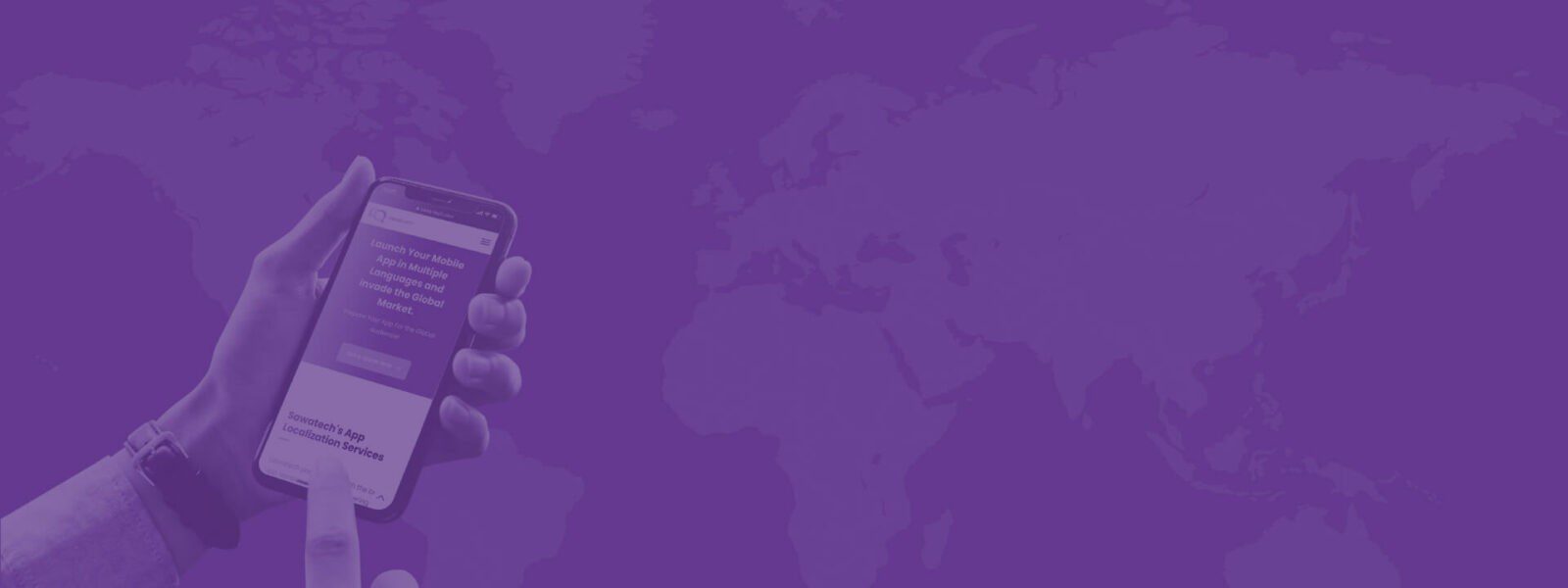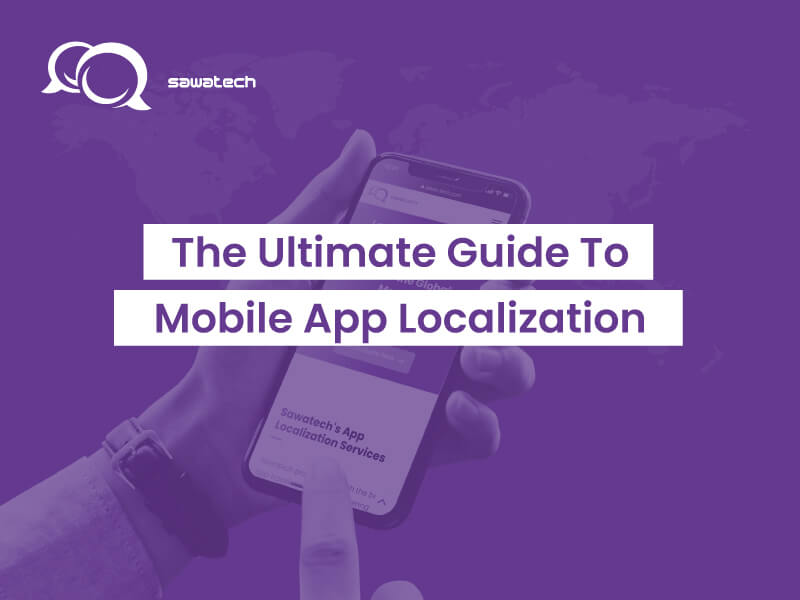[/vc_column_text][/vc_column][/vc_row]
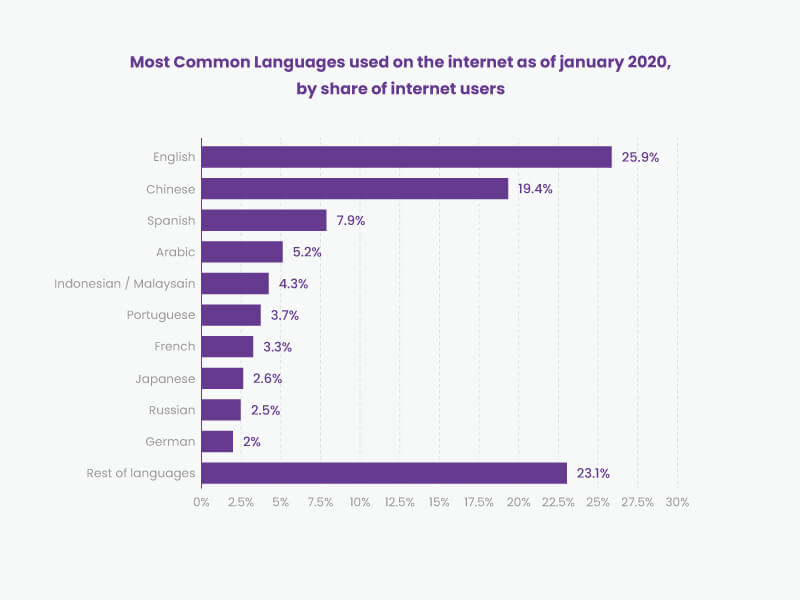
-
- English – 25.9%
- Chinese – 19.4%
- Spanish – 7.9%
- Arabic – 5.2%
- Indonesian/Malaysian – 4.2%
- Portuguese – 3.7%
- French – 3.3%
- Japanese – 2.6%
- Russian – 2.5%
- German – 2%
So now you can decide which language to localize your mobile app in.
Understand Your Target Audience
It is essential that you understand the culture and preferences of your target audience before you start localization. You have to consider factors like their age, gender, interests and other demographics. It will help you tailor your localized app for a specific user segment, leading to higher engagement and user loyalty.
When localizing a mobile app, you should consider the text, designs and visuals. For example, some colors are associated with different emotions in various cultures. You must consider these cultural nuances to ensure that your content appeals to the target audience rather than offending or repelling them.
In addition to visual elements like colors, you must consider the currency, payment options and other formatting conventions. If you are targeting an international audience, ensure that your app is compatible with multiple currencies. It will make it easier for customers from different countries to use your services without hassle.
If you take the time to understand the culture and preferences of your target audience, you can create an app that resonates with them. It will lead to higher engagement and user loyalty. So make sure you do thorough research before starting any localization project.
Research Your Competitors
We say competitors are your best friends if you want to succeed. It would be best if you always researched what your competitors are doing in the market. It will help you get an idea of how they are localizing their apps and you can use that knowledge to decide how to localize yours.
And the best part is that you can learn from their mistakes and take advantage of the opportunities they are missing.
Find A Professional Translation Services Provider
If you are thinking about Artificial intelligence (AI) machine translation tools like Google Translate and the likes of it, they might be helpful. Still, they cannot compete with human translation in terms of accuracy and respect to cultural and contextual nuances.
For this reason and for a cross-disciplinary projects like app localization, you’ll need the expertise of a language services provider, with teams of native-speaking translators and reviewers who are residents in your target markets. This way, they’ll have first-hand knowledge of the language and culture they are translating to and ensure accurate and relevant translations.
Test, Improve, and Repeat
Localizing you app is only half battle. The other half is App Localization Testing. Your multilingual app can’t live without going through a meticulous testing process to validate your app’s translated content and functionality. App localization testing is multi-layered and should be performed by a team of language and localization as well as testing experts to identify linguistic, visual, and technical issues and fix them to release an appealing mobile app that your target users can use with ease.
Collect Feedback After Localization
Your job is not done after just localizing your app. You should always keep an eye on the feedback you are receiving from users and take the necessary steps to improve the app accordingly.
Collecting feedback will also help you understand what the users like about your localized app and what other features they want to be added.
Because cultural, language and local marketing trends keep changing, it is important to ensure your app is up-to-date.
Sawa-Tech Can Help With App Localization
Suppose you’re looking for a professional translation and localization service provider to help you with mobile app localization services.
In that case, Sawatech is a perfect choice. We have almost 10 years of experience in the industry, our team of experts can help you professional localization services, translating your app into any language with efficiency and precision.
Our team of experts and industry-leading translation technology and tools can help you to get the most out of your application localization project. So if you want to succeed in global markets, contact us today to get a quote and let’s start localizing your mobile app together.
[/vc_column_text][/vc_column][/vc_row]

-
- English – 25.9%
- Chinese – 19.4%
- Spanish – 7.9%
- Arabic – 5.2%
- Indonesian/Malaysian – 4.2%
- Portuguese – 3.7%
- French – 3.3%
- Japanese – 2.6%
- Russian – 2.5%
- German – 2%
So now you can decide which language to localize your mobile app in.
Understand Your Target Audience
It is essential that you understand the culture and preferences of your target audience before you start localization. You have to consider factors like their age, gender, interests and other demographics. It will help you tailor your localized app for a specific user segment, leading to higher engagement and user loyalty.
When localizing a mobile app, you should consider the text, designs and visuals. For example, some colors are associated with different emotions in various cultures. You must consider these cultural nuances to ensure that your content appeals to the target audience rather than offending or repelling them.
In addition to visual elements like colors, you must consider the currency, payment options and other formatting conventions. If you are targeting an international audience, ensure that your app is compatible with multiple currencies. It will make it easier for customers from different countries to use your services without hassle.
If you take the time to understand the culture and preferences of your target audience, you can create an app that resonates with them. It will lead to higher engagement and user loyalty. So make sure you do thorough research before starting any localization project.
Research Your Competitors
We say competitors are your best friends if you want to succeed. It would be best if you always researched what your competitors are doing in the market. It will help you get an idea of how they are localizing their apps and you can use that knowledge to decide how to localize yours.
And the best part is that you can learn from their mistakes and take advantage of the opportunities they are missing.
Find A Professional Translation Services Provider
If you are thinking about Artificial intelligence (AI) machine translation tools like Google Translate and the likes of it, they might be helpful. Still, they cannot compete with human translation in terms of accuracy and respect to cultural and contextual nuances.
For this reason and for a cross-disciplinary projects like app localization, you’ll need the expertise of a language services provider, with teams of native-speaking translators and reviewers who are residents in your target markets. This way, they’ll have first-hand knowledge of the language and culture they are translating to and ensure accurate and relevant translations.
Test, Improve, and Repeat
Localizing you app is only half battle. The other half is App Localization Testing. Your multilingual app can’t live without going through a meticulous testing process to validate your app’s translated content and functionality. App localization testing is multi-layered and should be performed by a team of language and localization as well as testing experts to identify linguistic, visual, and technical issues and fix them to release an appealing mobile app that your target users can use with ease.
Collect Feedback After Localization
Your job is not done after just localizing your app. You should always keep an eye on the feedback you are receiving from users and take the necessary steps to improve the app accordingly.
Collecting feedback will also help you understand what the users like about your localized app and what other features they want to be added.
Because cultural, language and local marketing trends keep changing, it is important to ensure your app is up-to-date.
Sawa-Tech Can Help With App Localization
Suppose you’re looking for a professional translation and localization service provider to help you with mobile app localization services.
In that case, Sawatech is a perfect choice. We have almost 10 years of experience in the industry, our team of experts can help you professional localization services, translating your app into any language with efficiency and precision.
Our team of experts and industry-leading translation technology and tools can help you to get the most out of your application localization project. So if you want to succeed in global markets, contact us today to get a quote and let’s start localizing your mobile app together.
[/vc_column_text][/vc_column][/vc_row]
These terms are often used interchangeably, but they mean two different things.
Localization
Localization is customizing your app for a specific region or market, making it more likely to appeal to users in that region. This means that you app should meet the linguistic, cultural, and technical requirements of your target users.
Internationalization
On the other hand, internationalization is the process of designing and developing your software or mobile application product so it can be adapted and localized to different cultures, regions, and languages. In other words, it makes your app localization-friendly, and streamlines the entire process from here.
When it comes to localization and internationalization, it’s not matter of this or that. It’s this and that. And it’s a matter of what comes first, which is internationalization. Internationalization involves neutralizing/enabling code to support the language, local, and cultural features that localization should add.
Without internationalization, localization can become quite an unpleasant (costly) experience for your brand and teams. This is because, in that case, your app localization will entail fundamental re-engineering efforts to fit the new users’ language and cultural preferences.
6 Tips for Mobile App Localization
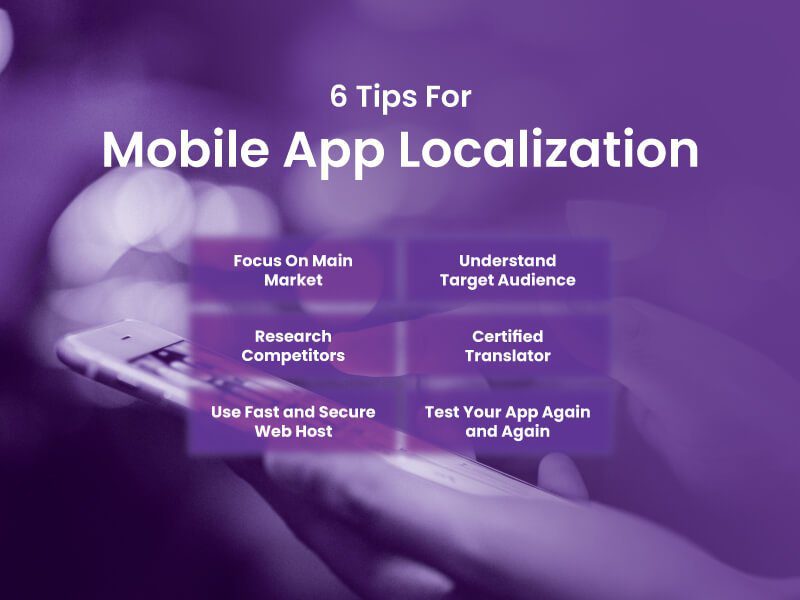
Now let’s come to the main part. Application localization is more involved than it sounds. You have to consider many different factors to have a successful localized app. Here are some tips for mobile app localization:
Focus on the Most Profitable Regions and Languages
You cannot localize your mobile app in every language, right? That’s why you should focus on the most profitable regions and languages. It will help you to save time and money while helping to maximize your return on investment. According to statistics, the most common languages used on the internet are:

-
- English – 25.9%
- Chinese – 19.4%
- Spanish – 7.9%
- Arabic – 5.2%
- Indonesian/Malaysian – 4.2%
- Portuguese – 3.7%
- French – 3.3%
- Japanese – 2.6%
- Russian – 2.5%
- German – 2%
So now you can decide which language to localize your mobile app in.
Understand Your Target Audience
It is essential that you understand the culture and preferences of your target audience before you start localization. You have to consider factors like their age, gender, interests and other demographics. It will help you tailor your localized app for a specific user segment, leading to higher engagement and user loyalty.
When localizing a mobile app, you should consider the text, designs and visuals. For example, some colors are associated with different emotions in various cultures. You must consider these cultural nuances to ensure that your content appeals to the target audience rather than offending or repelling them.
In addition to visual elements like colors, you must consider the currency, payment options and other formatting conventions. If you are targeting an international audience, ensure that your app is compatible with multiple currencies. It will make it easier for customers from different countries to use your services without hassle.
If you take the time to understand the culture and preferences of your target audience, you can create an app that resonates with them. It will lead to higher engagement and user loyalty. So make sure you do thorough research before starting any localization project.
Research Your Competitors
We say competitors are your best friends if you want to succeed. It would be best if you always researched what your competitors are doing in the market. It will help you get an idea of how they are localizing their apps and you can use that knowledge to decide how to localize yours.
And the best part is that you can learn from their mistakes and take advantage of the opportunities they are missing.
Find A Professional Translation Services Provider
If you are thinking about Artificial intelligence (AI) machine translation tools like Google Translate and the likes of it, they might be helpful. Still, they cannot compete with human translation in terms of accuracy and respect to cultural and contextual nuances.
For this reason and for a cross-disciplinary projects like app localization, you’ll need the expertise of a language services provider, with teams of native-speaking translators and reviewers who are residents in your target markets. This way, they’ll have first-hand knowledge of the language and culture they are translating to and ensure accurate and relevant translations.
Test, Improve, and Repeat
Localizing you app is only half battle. The other half is App Localization Testing. Your multilingual app can’t live without going through a meticulous testing process to validate your app’s translated content and functionality. App localization testing is multi-layered and should be performed by a team of language and localization as well as testing experts to identify linguistic, visual, and technical issues and fix them to release an appealing mobile app that your target users can use with ease.
Collect Feedback After Localization
Your job is not done after just localizing your app. You should always keep an eye on the feedback you are receiving from users and take the necessary steps to improve the app accordingly.
Collecting feedback will also help you understand what the users like about your localized app and what other features they want to be added.
Because cultural, language and local marketing trends keep changing, it is important to ensure your app is up-to-date.
Sawa-Tech Can Help With App Localization
Suppose you’re looking for a professional translation and localization service provider to help you with mobile app localization services.
In that case, Sawatech is a perfect choice. We have almost 10 years of experience in the industry, our team of experts can help you professional localization services, translating your app into any language with efficiency and precision.
Our team of experts and industry-leading translation technology and tools can help you to get the most out of your application localization project. So if you want to succeed in global markets, contact us today to get a quote and let’s start localizing your mobile app together.
[/vc_column_text][/vc_column][/vc_row]
In the mobile app market, there are two commonly talked-about approaches to making your app accessible to users in different countries:-
- Localization
- Internationalization
These terms are often used interchangeably, but they mean two different things.
Localization
Localization is customizing your app for a specific region or market, making it more likely to appeal to users in that region. This means that you app should meet the linguistic, cultural, and technical requirements of your target users.
Internationalization
On the other hand, internationalization is the process of designing and developing your software or mobile application product so it can be adapted and localized to different cultures, regions, and languages. In other words, it makes your app localization-friendly, and streamlines the entire process from here.
When it comes to localization and internationalization, it’s not matter of this or that. It’s this and that. And it’s a matter of what comes first, which is internationalization. Internationalization involves neutralizing/enabling code to support the language, local, and cultural features that localization should add.
Without internationalization, localization can become quite an unpleasant (costly) experience for your brand and teams. This is because, in that case, your app localization will entail fundamental re-engineering efforts to fit the new users’ language and cultural preferences.
6 Tips for Mobile App Localization

Now let’s come to the main part. Application localization is more involved than it sounds. You have to consider many different factors to have a successful localized app. Here are some tips for mobile app localization:
Focus on the Most Profitable Regions and Languages
You cannot localize your mobile app in every language, right? That’s why you should focus on the most profitable regions and languages. It will help you to save time and money while helping to maximize your return on investment. According to statistics, the most common languages used on the internet are:

-
- English – 25.9%
- Chinese – 19.4%
- Spanish – 7.9%
- Arabic – 5.2%
- Indonesian/Malaysian – 4.2%
- Portuguese – 3.7%
- French – 3.3%
- Japanese – 2.6%
- Russian – 2.5%
- German – 2%
So now you can decide which language to localize your mobile app in.
Understand Your Target Audience
It is essential that you understand the culture and preferences of your target audience before you start localization. You have to consider factors like their age, gender, interests and other demographics. It will help you tailor your localized app for a specific user segment, leading to higher engagement and user loyalty.
When localizing a mobile app, you should consider the text, designs and visuals. For example, some colors are associated with different emotions in various cultures. You must consider these cultural nuances to ensure that your content appeals to the target audience rather than offending or repelling them.
In addition to visual elements like colors, you must consider the currency, payment options and other formatting conventions. If you are targeting an international audience, ensure that your app is compatible with multiple currencies. It will make it easier for customers from different countries to use your services without hassle.
If you take the time to understand the culture and preferences of your target audience, you can create an app that resonates with them. It will lead to higher engagement and user loyalty. So make sure you do thorough research before starting any localization project.
Research Your Competitors
We say competitors are your best friends if you want to succeed. It would be best if you always researched what your competitors are doing in the market. It will help you get an idea of how they are localizing their apps and you can use that knowledge to decide how to localize yours.
And the best part is that you can learn from their mistakes and take advantage of the opportunities they are missing.
Find A Professional Translation Services Provider
If you are thinking about Artificial intelligence (AI) machine translation tools like Google Translate and the likes of it, they might be helpful. Still, they cannot compete with human translation in terms of accuracy and respect to cultural and contextual nuances.
For this reason and for a cross-disciplinary projects like app localization, you’ll need the expertise of a language services provider, with teams of native-speaking translators and reviewers who are residents in your target markets. This way, they’ll have first-hand knowledge of the language and culture they are translating to and ensure accurate and relevant translations.
Test, Improve, and Repeat
Localizing you app is only half battle. The other half is App Localization Testing. Your multilingual app can’t live without going through a meticulous testing process to validate your app’s translated content and functionality. App localization testing is multi-layered and should be performed by a team of language and localization as well as testing experts to identify linguistic, visual, and technical issues and fix them to release an appealing mobile app that your target users can use with ease.
Collect Feedback After Localization
Your job is not done after just localizing your app. You should always keep an eye on the feedback you are receiving from users and take the necessary steps to improve the app accordingly.
Collecting feedback will also help you understand what the users like about your localized app and what other features they want to be added.
Because cultural, language and local marketing trends keep changing, it is important to ensure your app is up-to-date.
Sawa-Tech Can Help With App Localization
Suppose you’re looking for a professional translation and localization service provider to help you with mobile app localization services.
In that case, Sawatech is a perfect choice. We have almost 10 years of experience in the industry, our team of experts can help you professional localization services, translating your app into any language with efficiency and precision.
Our team of experts and industry-leading translation technology and tools can help you to get the most out of your application localization project. So if you want to succeed in global markets, contact us today to get a quote and let’s start localizing your mobile app together.
[/vc_column_text][/vc_column][/vc_row]
In the mobile app market, there are two commonly talked-about approaches to making your app accessible to users in different countries:
-
- Localization
- Internationalization
These terms are often used interchangeably, but they mean two different things.
Localization
Localization is customizing your app for a specific region or market, making it more likely to appeal to users in that region. This means that you app should meet the linguistic, cultural, and technical requirements of your target users.
Internationalization
On the other hand, internationalization is the process of designing and developing your software or mobile application product so it can be adapted and localized to different cultures, regions, and languages. In other words, it makes your app localization-friendly, and streamlines the entire process from here.
When it comes to localization and internationalization, it’s not matter of this or that. It’s this and that. And it’s a matter of what comes first, which is internationalization. Internationalization involves neutralizing/enabling code to support the language, local, and cultural features that localization should add.
Without internationalization, localization can become quite an unpleasant (costly) experience for your brand and teams. This is because, in that case, your app localization will entail fundamental re-engineering efforts to fit the new users’ language and cultural preferences.
6 Tips for Mobile App Localization

Now let’s come to the main part. Application localization is more involved than it sounds. You have to consider many different factors to have a successful localized app. Here are some tips for mobile app localization:
Focus on the Most Profitable Regions and Languages
You cannot localize your mobile app in every language, right? That’s why you should focus on the most profitable regions and languages. It will help you to save time and money while helping to maximize your return on investment. According to statistics, the most common languages used on the internet are:

-
- English – 25.9%
- Chinese – 19.4%
- Spanish – 7.9%
- Arabic – 5.2%
- Indonesian/Malaysian – 4.2%
- Portuguese – 3.7%
- French – 3.3%
- Japanese – 2.6%
- Russian – 2.5%
- German – 2%
So now you can decide which language to localize your mobile app in.
Understand Your Target Audience
It is essential that you understand the culture and preferences of your target audience before you start localization. You have to consider factors like their age, gender, interests and other demographics. It will help you tailor your localized app for a specific user segment, leading to higher engagement and user loyalty.
When localizing a mobile app, you should consider the text, designs and visuals. For example, some colors are associated with different emotions in various cultures. You must consider these cultural nuances to ensure that your content appeals to the target audience rather than offending or repelling them.
In addition to visual elements like colors, you must consider the currency, payment options and other formatting conventions. If you are targeting an international audience, ensure that your app is compatible with multiple currencies. It will make it easier for customers from different countries to use your services without hassle.
If you take the time to understand the culture and preferences of your target audience, you can create an app that resonates with them. It will lead to higher engagement and user loyalty. So make sure you do thorough research before starting any localization project.
Research Your Competitors
We say competitors are your best friends if you want to succeed. It would be best if you always researched what your competitors are doing in the market. It will help you get an idea of how they are localizing their apps and you can use that knowledge to decide how to localize yours.
And the best part is that you can learn from their mistakes and take advantage of the opportunities they are missing.
Find A Professional Translation Services Provider
If you are thinking about Artificial intelligence (AI) machine translation tools like Google Translate and the likes of it, they might be helpful. Still, they cannot compete with human translation in terms of accuracy and respect to cultural and contextual nuances.
For this reason and for a cross-disciplinary projects like app localization, you’ll need the expertise of a language services provider, with teams of native-speaking translators and reviewers who are residents in your target markets. This way, they’ll have first-hand knowledge of the language and culture they are translating to and ensure accurate and relevant translations.
Test, Improve, and Repeat
Localizing you app is only half battle. The other half is App Localization Testing. Your multilingual app can’t live without going through a meticulous testing process to validate your app’s translated content and functionality. App localization testing is multi-layered and should be performed by a team of language and localization as well as testing experts to identify linguistic, visual, and technical issues and fix them to release an appealing mobile app that your target users can use with ease.
Collect Feedback After Localization
Your job is not done after just localizing your app. You should always keep an eye on the feedback you are receiving from users and take the necessary steps to improve the app accordingly.
Collecting feedback will also help you understand what the users like about your localized app and what other features they want to be added.
Because cultural, language and local marketing trends keep changing, it is important to ensure your app is up-to-date.
Sawa-Tech Can Help With App Localization
Suppose you’re looking for a professional translation and localization service provider to help you with mobile app localization services.
In that case, Sawatech is a perfect choice. We have almost 10 years of experience in the industry, our team of experts can help you professional localization services, translating your app into any language with efficiency and precision.
Our team of experts and industry-leading translation technology and tools can help you to get the most out of your application localization project. So if you want to succeed in global markets, contact us today to get a quote and let’s start localizing your mobile app together.
[/vc_column_text][/vc_column][/vc_row]
So, you’ve got a shiny new app and want to make it available to the world. You know that for your endeavors to be successful (and profitable), your app will need to be localized into different languages for different countries.
However, localizing a mobile app is not exactly a breeze. It’s a complicated process, and you might get overwhelmed not knowing where and how to get started. And since you are going to put money, time, and energy into it, you might be hesitant whether to go for full-fledged localization or not, at least initially.
This guide will provide an overview of the localization process, from planning to release. So whether you’re just starting or looking to improve your existing localization strategy, read on for tips and insights that will help you take your app global with confidence
What Is Mobile App Localization?
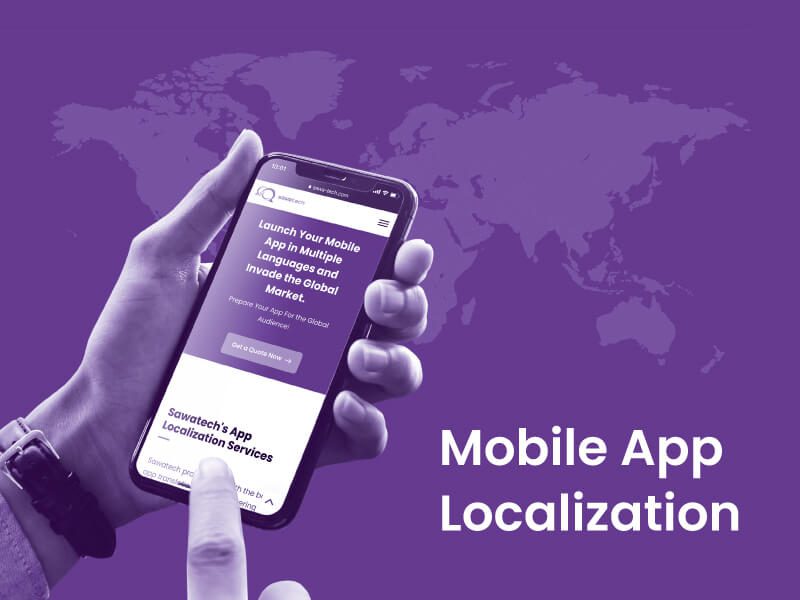
App localization is the process of translating an app into multiple languages to reach a global audience. The process involves translating the app’s text and ensuring the app’s design and layout, graphics, visual content, and the entire user flow are adjusted for each market.
In addition, localizing an app requires understanding cultural differences and how they might affect app usage. For example, certain colors may have different meanings in different cultures, and some gestures may be considered offensive. By considering these cultural nuances, businesses can ensure that their apps are appealing in various markets.
With localization, an app won’t look or feel foreign and unfamiliar to users in your target market. The thing which otherwise could lead to confusion and ultimately result in poor app reviews and downloads. In other words, mobile app localization doesn’t only set up your app’s global presence, but it essentially ensures your apps are well-received, maximizing your app’s global reach and engagement.
Types of Mobile Application Localization
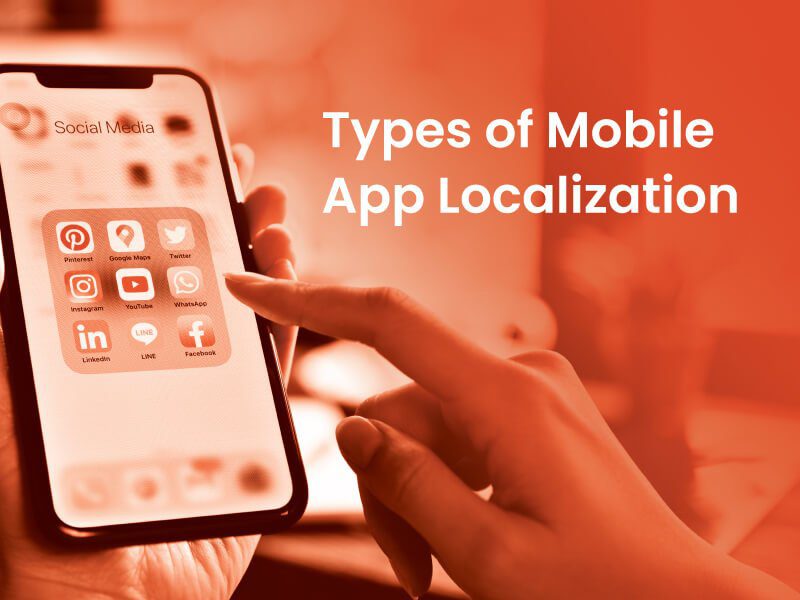
When it comes to localizing your mobile app, there are two types of localization that you should consider:
Minimum Viable Localization
MVL is the process of changing key features of an app to work in a specific market. It usually involves translating the app into the local language. Still, it can also involve making changes to the app to account for cultural differences.
The goal of MVL is to minimize the work required to launch an app in a new market while still providing a good user experience. To do this, MVL focuses on the most important markets and features and then makes incremental improvements over time.
This approach is less challenging (less overwhelming) and less expensive than traditional full-fledged mobile app localization. If you are looking to supercharge your app expansion, while keeping your budget and schedule under control, then MVL is the right strategy for you. Not only that, but MVL helps you scale up and streamline your localization efforts along the line.
Full App Localization
After MVL and when everything is going great according to your plan, now is the time to make your app fully localized. By ensuring that all areas of the app are localized, you can create a truly immersive experience for users in different markets. It includes changing the UI and UX elements to be more culturally relevant, revising copy to fit local norms, and translating content into multiple languages.
If you have been taking baby steps toward localization and are ready to dive into it full force, having the means and time, then this is the right time for your full-scale app localization. This localization approach ensures that your app isn’t just more widely available, but that it’s also fully adapted and optimized for your target users in ways that can spike your app downloads, conversion, and ROI.
Why Localize Your Mobile App?
According to Statista, 6.57 billion people worldwide use their mobile phones to access apps and websites.
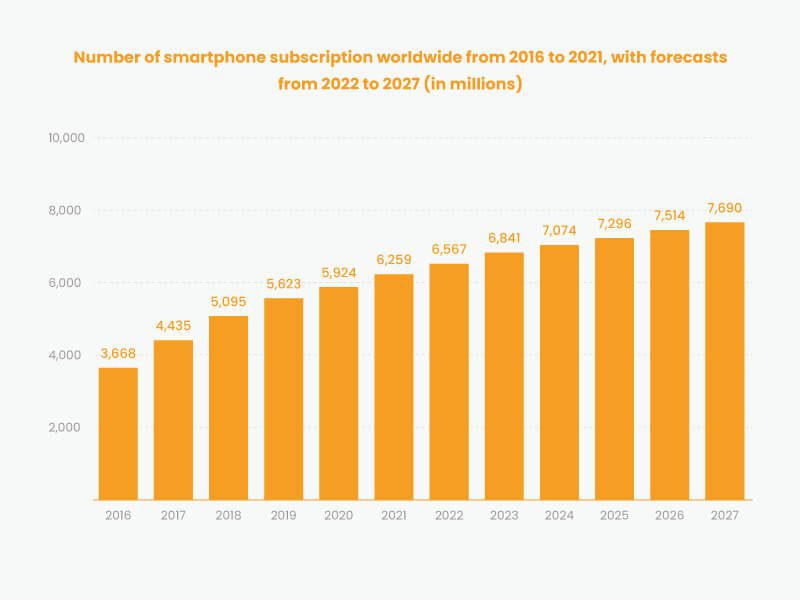
In a global market, it’s more important than ever to have a mobile app that can reach a wide audience.
Tapping Into New Markets
For example, you can see how Uber has localized its app for different countries worldwide. Now Uber has a reach across the globe in over 80 countries. Uber has translated its app content and tweaked and adjusted its app’s UI, UX, and graphics to fit different cultures. It ensures that users in those markets have an intuitive and enjoyable experience with the app.
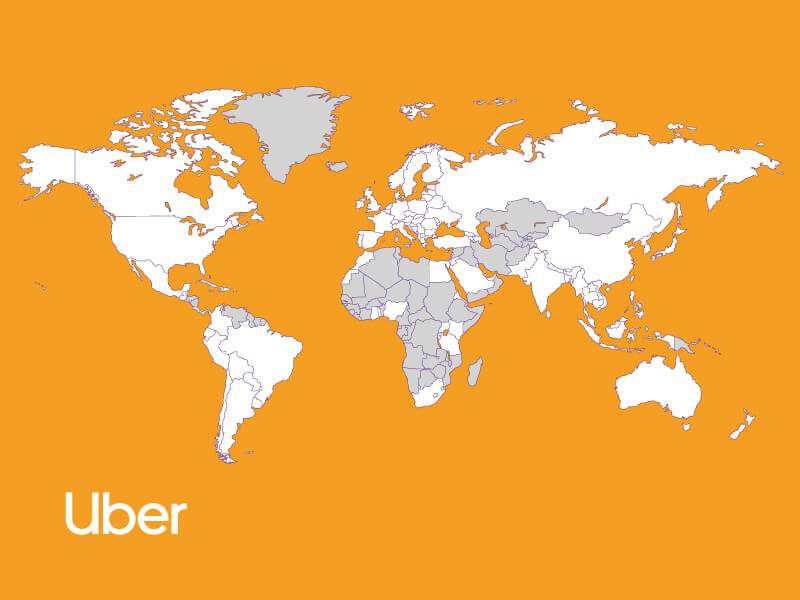
When it comes to market expansion, localization is key. After all, if your app isn’t localized for a certain market, it may be difficult for people to understand or use. Localizing your mobile app for different markets allows you to tap into new customer segments and expand your brand’s reach.
Growing App Engagement
Users who see an app’s description written in their language are more likely to engage with it. It is because they already understand the content and don’t have to learn how to use unfamiliar words or icons. We know that English is a universal language but still, 72.1 % of customers prefer to use websites in their native tongue for most of their online activities.
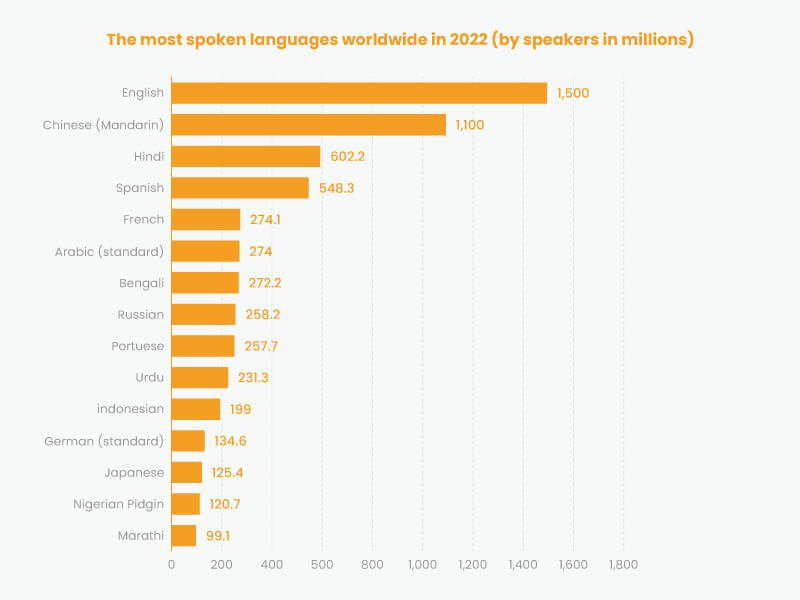
For example, if a user from China sees an app in Chinese, they will be more likely to download and use the app than an English version. Localizing your mobile app for different markets can increase engagement and user loyalty.
Increasing App Downloads and Visibility
Having an app, you probably are striving for it to rank higher in app store platforms. To achieve this, there are several factors to consider. According to App Radar, app localization hasn’t been deemed a ranking factor per se, but it still has an impact on user experience and conversion rates, accordingly making it a potential ranking factor. Now, if your app store descriptions are written in the native language, ranking algorithms will recognize users’ interest and engagement with your app, eventually allowing it to rank higher in the app store search results.
Boosting Sales
Every business wants to boost sales, and localizing your mobile app can help you achieve this. When users see an app that speaks to them in their language and culture, they are more likely to purchase or take advantage of offers within the app.
Localizing your app not only increases its chances for success, but also drives more revenue. The average increase is 126% when localization strategies are implemented in the development stage and over twice as much if you translate it before releasing.
Mobile App Localization Vs. Mobile App Internationalization
In the mobile app market, there are two commonly talked-about approaches to making your app accessible to users in different countries:
-
- Localization
- Internationalization
These terms are often used interchangeably, but they mean two different things.
Localization
Localization is customizing your app for a specific region or market, making it more likely to appeal to users in that region. This means that you app should meet the linguistic, cultural, and technical requirements of your target users.
Internationalization
On the other hand, internationalization is the process of designing and developing your software or mobile application product so it can be adapted and localized to different cultures, regions, and languages. In other words, it makes your app localization-friendly, and streamlines the entire process from here.
When it comes to localization and internationalization, it’s not matter of this or that. It’s this and that. And it’s a matter of what comes first, which is internationalization. Internationalization involves neutralizing/enabling code to support the language, local, and cultural features that localization should add.
Without internationalization, localization can become quite an unpleasant (costly) experience for your brand and teams. This is because, in that case, your app localization will entail fundamental re-engineering efforts to fit the new users’ language and cultural preferences.
6 Tips for Mobile App Localization

Now let’s come to the main part. Application localization is more involved than it sounds. You have to consider many different factors to have a successful localized app. Here are some tips for mobile app localization:
Focus on the Most Profitable Regions and Languages
You cannot localize your mobile app in every language, right? That’s why you should focus on the most profitable regions and languages. It will help you to save time and money while helping to maximize your return on investment. According to statistics, the most common languages used on the internet are:

-
- English – 25.9%
- Chinese – 19.4%
- Spanish – 7.9%
- Arabic – 5.2%
- Indonesian/Malaysian – 4.2%
- Portuguese – 3.7%
- French – 3.3%
- Japanese – 2.6%
- Russian – 2.5%
- German – 2%
So now you can decide which language to localize your mobile app in.
Understand Your Target Audience
It is essential that you understand the culture and preferences of your target audience before you start localization. You have to consider factors like their age, gender, interests and other demographics. It will help you tailor your localized app for a specific user segment, leading to higher engagement and user loyalty.
When localizing a mobile app, you should consider the text, designs and visuals. For example, some colors are associated with different emotions in various cultures. You must consider these cultural nuances to ensure that your content appeals to the target audience rather than offending or repelling them.
In addition to visual elements like colors, you must consider the currency, payment options and other formatting conventions. If you are targeting an international audience, ensure that your app is compatible with multiple currencies. It will make it easier for customers from different countries to use your services without hassle.
If you take the time to understand the culture and preferences of your target audience, you can create an app that resonates with them. It will lead to higher engagement and user loyalty. So make sure you do thorough research before starting any localization project.
Research Your Competitors
We say competitors are your best friends if you want to succeed. It would be best if you always researched what your competitors are doing in the market. It will help you get an idea of how they are localizing their apps and you can use that knowledge to decide how to localize yours.
And the best part is that you can learn from their mistakes and take advantage of the opportunities they are missing.
Find A Professional Translation Services Provider
If you are thinking about Artificial intelligence (AI) machine translation tools like Google Translate and the likes of it, they might be helpful. Still, they cannot compete with human translation in terms of accuracy and respect to cultural and contextual nuances.
For this reason and for a cross-disciplinary projects like app localization, you’ll need the expertise of a language services provider, with teams of native-speaking translators and reviewers who are residents in your target markets. This way, they’ll have first-hand knowledge of the language and culture they are translating to and ensure accurate and relevant translations.
Test, Improve, and Repeat
Localizing you app is only half battle. The other half is App Localization Testing. Your multilingual app can’t live without going through a meticulous testing process to validate your app’s translated content and functionality. App localization testing is multi-layered and should be performed by a team of language and localization as well as testing experts to identify linguistic, visual, and technical issues and fix them to release an appealing mobile app that your target users can use with ease.
Collect Feedback After Localization
Your job is not done after just localizing your app. You should always keep an eye on the feedback you are receiving from users and take the necessary steps to improve the app accordingly.
Collecting feedback will also help you understand what the users like about your localized app and what other features they want to be added.
Because cultural, language and local marketing trends keep changing, it is important to ensure your app is up-to-date.
Sawa-Tech Can Help With App Localization
Suppose you’re looking for a professional translation and localization service provider to help you with mobile app localization services.
In that case, Sawatech is a perfect choice. We have almost 10 years of experience in the industry, our team of experts can help you professional localization services, translating your app into any language with efficiency and precision.
Our team of experts and industry-leading translation technology and tools can help you to get the most out of your application localization project. So if you want to succeed in global markets, contact us today to get a quote and let’s start localizing your mobile app together.

